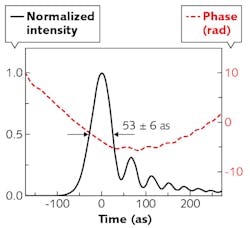53-attosecond x-ray pulses will enable study of electrons in live biological samples

Researchers from the Institute for the Frontier of Attosecond Science and Technology, CREOL, University of Central Florida (Orlando, FL) and the Beijing National Laboratory for Condensed Matter Physics, Institute of Physics, Chinese Academy of Sciences (Beijing, China) have demonstrated the shortest light pulse ever developed, a 53-attosecond (as) x-ray (100–330 eV) flash produced via high-harmonic generation (HHG). The x-ray energies reach the carbon K-absorption edge at 284 eV, which will enable the study of electron dynamics in live biological samples. The group, led by CREOL professor Zenghu Chang, beat its own world record set in 2012, in which 67-as extreme ultraviolet (EUV) light pulses were created.
Producing attosecond x-rays required a new type of high power driver: femtosecond lasers with a relatively long center wavelength of 1.8 μm producing two-optical-cycle driving pulses. It's an approach that Chang and his team have pioneered. The attosecond pulse duration is not transform-limited, but is instead limited by the frequency chirp of the pulses. Attosecond light pulses allow scientists to capture "freeze-frame" images of fast-moving electrons in atoms and molecules with unprecedented sharpness. The pulses Chang and his team have now demonstrated are shorter in wavelength as well as duration. The wavelength band of the new pulses reaches the so-called "water window," where carbon atoms absorb strongly, but water does not. X-rays interact with tightly bound electrons in matter, providing another way to study ultrafast processes in materials with chemical element specificity. Reference: J. Li et al., Nat. Commun. (2017); doi:10.1038/s41467-017-00321-0.
About the Author
John Wallace
Senior Technical Editor (1998-2022)
John Wallace was with Laser Focus World for nearly 25 years, retiring in late June 2022. He obtained a bachelor's degree in mechanical engineering and physics at Rutgers University and a master's in optical engineering at the University of Rochester. Before becoming an editor, John worked as an engineer at RCA, Exxon, Eastman Kodak, and GCA Corporation.
